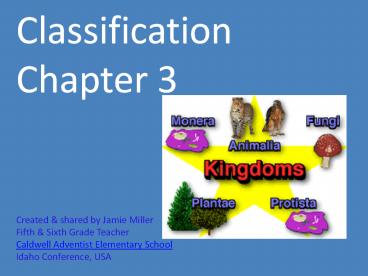Classification Chapter 3 Created - PowerPoint PPT Presentation
Title:
Classification Chapter 3 Created
Description:
Mollusks and arthropods Plants and animals Birds and insects Vertebrates and mollusks 5. ... Producers include all green plants and some protists. – PowerPoint PPT presentation
Number of Views:131
Avg rating:3.0/5.0
Title: Classification Chapter 3 Created
1
ClassificationChapter 3 Created
shared by Jamie MillerFifth Sixth Grade
TeacherCaldwell Adventist Elementary
SchoolIdaho Conference, USA
2
1. What is one advantage of using scientific
names?
- The scientific name is easier to learn
- The scientific name often describes the organism
- The scientific name can be translated to English
easily - The scientific name is the first name used for an
organism
3
- What is the process by which organisms are
organized? - Phyla
- Sorting
- Classification
- Distributing
4
- What is the most specific level of classification
used - by scientists?
- Class
- Species
- Family
- Genus
5
- Which of the following are examples of classes?
- Mollusks and arthropods
- Plants and animals
- Birds and insects
- Vertebrates and mollusks
6
5. What characteristics are used in classifying
things into kingdoms?
- Number of cells, producers or consumers, type of
cells - Number of cells, types of skin, feet or fins
- Producers, consumers, vertebrate or invertebrate,
type of cells - Color of eyes, type of cells, lungs or gills
7
6. Which of the following is an organism that
cannot make its own food?
- Producer
- Invertebrate
- User
- Consumer
8
7. Which of the following is not used in
classifying organisms into a particular phylum?
- Habitat
- Body structure
- Food
- Consumers or producers
9
- What is an example of an invertebrate?
- Salmon
- Whale
- Giant squid
- Dolphin
10
- Which phylum is characterized as having a body
with many pores or openings?
- Worms
- Sponges
- Echinoderms
- Arthropods
11
- Which gives the correct order for the levels
of classification?
- Phylum, kingdom, species, genus, family, order,
class - Species, family, kingdom, phylum, order, class,
genus - Kingdom, phylum, class, order, family, genus,
species - None of these
12
11. Which is an advantage of classifying a
collection of things?
- It makes the collection easier to study
- It makes it harder for people to steal the
collections - It makes it easier to store the items
- It preserves the collection
13
- In what language are scientific names written?
- English
- Latin
- Spanish
- French
14
13. Which of the following animals would be a
mollusk?
- A spider
- A clam
- A worm
- A starfish
15
14. Which subgroup would make up a family?
- Species
- Phylum
- Genus
- None of these
16
15. Which kingdom is made up of organisms that
are usually single-celled and often have a cell
wall?
- Animal
- Monera
- Vertebrate
- Protist
17
16. Which organism has stinging tentacles?
- Starfish
- Sea anemone
- Shrimp
- Sponge
18
17. Which of the following is not a
characteristic of the arthropod phylum?
- Tube feet
- Antennae
- Jointed legs
- Exoskeleton
19
Part 2 Matching Match each pictured organism with
the phylum to which it belongs. Write the letter
of the organism on the line provided.
18. ______ arthropod phylum 19. ______ cnidaria
phylum 20. ______ echinoderm phylum 21. ______
mollusk phylum 22. ______ sponge phylum
20
23. What features are used when classifying
animals?
Body structure is most important, but other
features include food, habitat, and behavior.
21
24. Identify the five kingdoms used in scientific
classification, and give an example of each
kingdom.
Monera-bacteria protista-paramecium
fungus-mold plant-rose animal-horse
22
- Explain the difference between a producer and a
consumer. - Produces are organisms that can produce their
own food. Producers include all green plants and
some protists. Producers use the process of
photosynthesis to produce food. Consumers are
organisms that cannot photosynthesize to produce
their own food. They must therefore get their
food from eating producers or other consumers.
Consumers include all animals some protists, and
many fungi.































